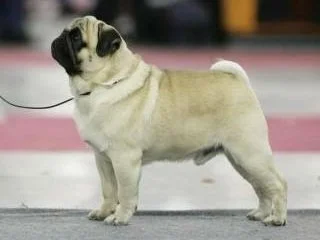The AKC Description And pug Standard
About the pug Breed
Once the mischievous companion of Chinese emperors, and later the mascot of Holland's royal House of Orange, the small but solid Pug is today adored by his millions of fans around the world. Pugs live to love and to be loved in return. The Pug's motto is the Latin phrase 'multum in parvo' (a lot in a little) an apt description of this small but muscular breed. They come in three colors: silver or apricot-fawn with a black face mask, or all black. The large round head, the big, sparkling eyes, and the wrinkled brow give Pugs a range of human-like expressions' surprise, happiness, curiosity 'that have delighted owners for centuries. Pug owners say their breed is the ideal house dog. Pugs are happy in the city or country, with kids or old folks, as an only pet or in a pack. They enjoy their food, and care must be taken to keep them trim. They do best in moderate climates' not too hot, not too cold' but, with proper care, Pugs can be their adorable selves anywhere.
AKC
Official Standard of the Pug
General Appearance: Symmetry and general appearance are decidedly square and cobby. A
lean, leggy Pug and a dog with short legs and a long body are equally objectionable.
Size, Proportion, Substance: The Pug should be multum in parvo, and this condensation (if the
word may be used) is shown by compactness of form, well knit proportions, and hardness of
developed muscle. Weight from 14 to 18 pounds (dog or bitch) desirable. Proportion square.
Head: The head is large, massive, round - not apple-headed, with no indentation of the skull.
The eyes are dark in color, very large, bold and prominent, globular in shape, soft and solicitous
in expression, very lustrous, and, when excited, full of fire. The ears are thin, small, soft, like
black velvet. There are two kinds - the "rose" and the "button." Preference is given to the latter.
The wrinkles are large and deep. The muzzle is short, blunt, square, but not upfaced. Bite - A
Pug's bite should be very slightly undershot.
Neck, Topline, Body: The neck is slightly arched. It is strong, thick, and with enough length to
carry the head proudly. The short back is level from the withers to the high tail set. The body is
short and cobby, wide in chest and well ribbed up. The tail is curled as tightly as possible over
the hip. The double curl is perfection.
Forequarters: The legs are very strong, straight, of moderate length, and are set well under. The
elbows should be directly under the withers when viewed from the side. The shoulders are
moderately laid back. The pasterns are strong, neither steep nor down. The feet are neither so
long as the foot of the hare, nor so round as that of the cat; well split-up toes, and the nails black.
Dewclaws are generally removed.
Hindquarters: The strong, powerful hindquarters have moderate bend of stifle and short hocks
perpendicular to the ground. The legs are parallel when viewed from behind. The hindquarters
are in balance with the forequarters. The thighs and buttocks are full and muscular. Feet as in
front.
Coat: The coat is fine, smooth, soft, short and glossy, neither hard nor woolly.
Color: The colors are fawn or black. The fawn color should be decided so as to make the
contrast complete between the color and the trace and mask.
Markings: The markings are clearly defined. The muzzle or mask, ears, moles on cheeks, thumb
mark or diamond on forehead, and the back trace should be as black as possible. The mask
should be black. The more intense and well defined it is, the better. The trace is a black line
extending from the occiput to the tail.
Gait: Viewed from the front, the forelegs should be carried well forward, showing no weakness
in the pasterns, the paws landing squarely with the central toes straight ahead. The rear action
should be strong and free through hocks and stifles, with no twisting or turning in or out at the
joints. The hind legs should follow in line with the front. There is a slight natural convergence of
the limbs both fore and aft. A slight roll of the hindquarters typifies the gait which should be
free, self-assured, and jaunty.
Temperament: This is an even-tempered breed, exhibiting stability, playfulness, great charm,
dignity, and an outgoing, loving disposition.
Disqualification - Any color other than fawn or black.
Approved April 8, 2008
Effective June 3, 2008

